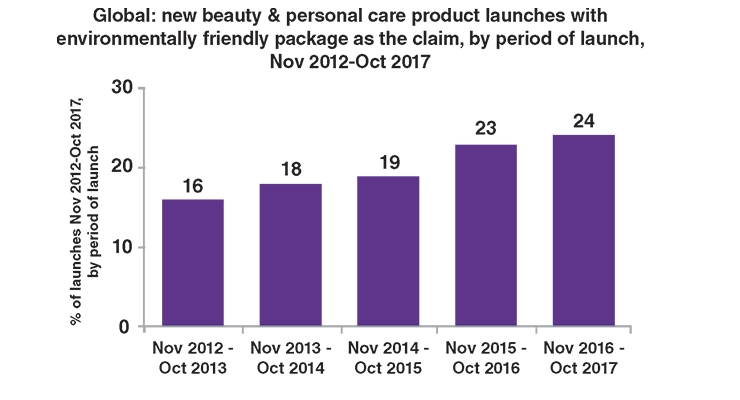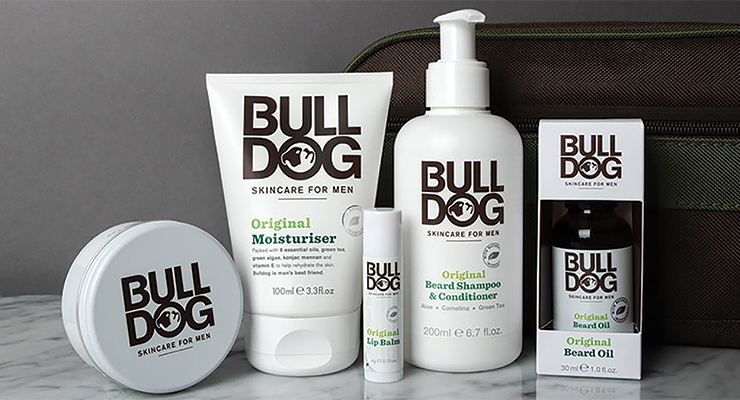Regina Haydon, Global Food & Drink Analyst, Mintel04.30.18
Consumers are becoming increasingly knowledgeable about product ingredients, how they are sourced and their eventual impact on health, well-being and appearance. This leads to the development of more natural beauty product formulations, or at least toward more careful selection of ingredients and methods of preparation. However, as consumers are also becoming more environmentally-aware, beauty product ingredients and formulations are not the only product features that are being scrutinized.
Packaging is now central to environmental thinking, with more brands taking real actions in order to relate to eco-conscious consumers. Whether it is recyclable, made from recyclable materials, or biodegradable, packaging has become a key focus of innovation for a growing number of beauty brands.
More brands are developing environmentally-friendly packaging
Environmentally-friendly packaging claims represented 9% of beauty and personal care product launches globally in 2017. However, their number has recently been on the rise.
Consumers are more mindful about the environment
Mintel’s trend Hungry Planet points out that consumers are becoming interested in brands that follow eco-friendly practices and support sustainable development.
IN THE UK: 39% of beauty and personal care consumers expect to be able to recycle all packaging for these products.
IN BRAZIL: 46% of consumers try to recycle as much as possible.
IN THE U.S.: 26% of beauty and personal care consumers say personal care packaging should be environmentally-friendly.
Base: 1,397 UK internet users aged 16+ who have bought BPC products in the last six months; 1,463 Brazil internet users aged 16+; 1,978 US internet users aged 18+ who purchase personal care products
Source: Lightspeed/Mintel
Meeting Consumer Expectations Around Sustainable Packaging
Despite growing interest in more sustainable pack solutions, plastic remains a dominant pack material within the beauty and personal care industry thanks to its practicality and cheaper price. For instance, in the UK, 40% of plastic consumption is from packaging, with 2.4 million tons of packaging waste generated per year—1.7 million tons of which is from households. Moreover, the specific needs of beauty product storage often renders the sourcing of eco-friendly materials a serious challenge.
However, alongside the development of more environmentally-friendly beauty products, consumers are placing more pressure on packaging to be more sustainable and eco-friendly. This gradually encourages more brands to explore new environmentally-friendly packaging initiatives, including the use of marine plastics.
Bulldog Opts for Sugarcane
Bulldog Skincare for Men, a UK brand that creates natural skincare products for male consumers, has announced the replacement of its traditional plastic tubes with packaging derived from sugarcane in order to significantly reduce its environmental impact and carbon dioxide emissions.
It is a logical step for a vegan-friendly, “natural” brand that avoids the use of artificial colors and synthetic fragrances. In the year up to January 2016, the brand recorded a 27% sales increase and growing popularity among young men, especially within the 16-24 age group. News about sustainable pack launches should help this brand maintain its performance and potentially lead to further sales growth.
More Sustainability Statements are Being Made by Mass Brands
At the beginning of 2017, Unilever announced that by 2025 all of its plastic packaging would be fully reusable, recyclable or compostable.
It is not the first of this type of commitment from the company. As a part of the Unilever Sustainable Living Plan, it has already claimed to reduce the weight of packaging by one third by 2020, and to increase usage of recycled plastics to 25% by 2025.
Transparent and Realistic Plans Can Help Achieve Sustainability Goals
With more information at their disposal, consumers are more able than ever to track and scrutinize sustainability promises made by beauty brands. And as social media is a powerful tool in the hand of consumers, any mistakes in failing to achieve sustainability goals and deliver promised environmentally-friendly products and packaging can be extremely costly. It is therefore key for beauty brands to set realistic and transparent goals as well as allowing consumers to monitor progress of real steps toward sustainable business practices.
Key Recommendations
Sustainability has become more actionable than ever before, with brands taking steps to launch eco-friendly packs and products to resonate with environmentally-conscious consumers. However, consistency is key. Eco-friendly beauty brands are expected to be more proactive in promoting sustainable practices, including usage of environmentally-friendly packaging. Even small efforts in making packaging more environmentally-friendly can help brands obtain a key point of differentiation and achieve sustainability targets.
ABOUT THE AUTHOR
Regina Haydon is Global Food & Drink Analyst, Mintel. Email her here.































